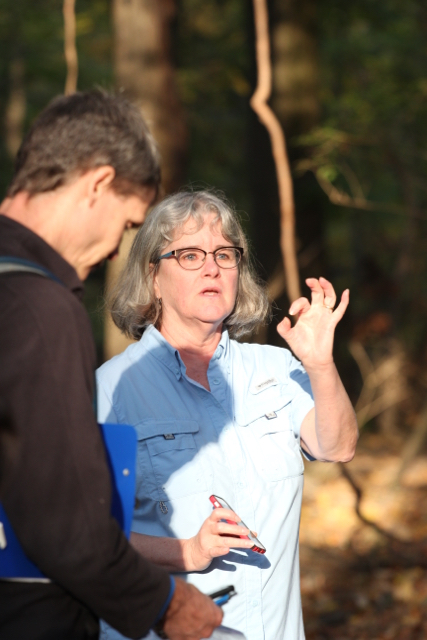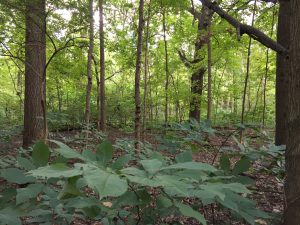By Rebecca Dolan, Ph.D.
A wonderful remnant of Eastern Deciduous forest has been secured on the grounds of Crown Hill Cemetery for 150 years. The woods on the northern edge of the cemetery, between Michigan Road and Clarendon, are a sanctuary for plants and wildlife that sustained our pioneers and were characteristic of early Marion County. Just as the inscriptions on the grave markers are a reminder of, and tribute to, our forbearers, the woods are a legacy of the past, linking generations. Woods of this size and quality is not found in many places in central Indiana.
 These woods are special. Most of our parks with natural areas in Marion County are along rivers, creeks, and streams, places like Holliday Park, Marott Park, and parts of Eagle Creek Park. The relatively steep topography of these sites prevented their being cleared for agriculture. The Crown Hill woods are close to White River, but far enough away to be out of the floodplain and flat. This terrain hosts flatwoods with shallow depressions called spring ponds that hold several inches of water in the spring. Because of the spring ponding, flatwoods were the last areas to be developed or farmed by settlers. Now, these special places are some of the last truly natural areas in central Indiana. The presence of spring ponds adds habitat diversity to the Crown Hill woods. At least 47 species of trees grow here. Impressively, the interior of the woods is largely free of invasive, non-native pest plants that are a scourge in many urban natural areas.
These woods are special. Most of our parks with natural areas in Marion County are along rivers, creeks, and streams, places like Holliday Park, Marott Park, and parts of Eagle Creek Park. The relatively steep topography of these sites prevented their being cleared for agriculture. The Crown Hill woods are close to White River, but far enough away to be out of the floodplain and flat. This terrain hosts flatwoods with shallow depressions called spring ponds that hold several inches of water in the spring. Because of the spring ponding, flatwoods were the last areas to be developed or farmed by settlers. Now, these special places are some of the last truly natural areas in central Indiana. The presence of spring ponds adds habitat diversity to the Crown Hill woods. At least 47 species of trees grow here. Impressively, the interior of the woods is largely free of invasive, non-native pest plants that are a scourge in many urban natural areas.
Forests like the woods at Crown Hill can be divided into three layers based on height above the ground. The upper layer, closest to the heavens, is the canopy. Just like with a canopy bed, this is the layer over your head. Very large and old trees hold their leaves up to the sun. Among the largest and oldest are burr oaks. Some in the woods measure over fifteen feet around and are likely several hundred years old. Although the woods at Crown Hill are isolated from other woods with burr oaks, the trees can communicate across the landscape via their pollen. The pollen of oaks travels on the wind and can cross fairly large spaces. Trees at Crown Hill preserve the gene pool of early Indiana and so connect the past with the present. Ashes, tulip poplars, sycamores, hickories, cottonwoods, silver, and sugar maple also thrive at Crown Hill. At least two dozen trees are over three feet in diameter.
The canopy is home to tree nesting fox and gray squirrels. Raccoons and opossums hang out in their branches. Pileated woodpeckers, large birds up to two feet in length with calls sounding like Woody- -The-Woodpecker, fly through the tree-tops like parrots through the rainforest. Both woodpeckers and squirrels nest in hollow parts of mature, often dead, old trees in forest habitat. Squirrels also build leaf nests to protect their young and to keep warm in winter. Squirrels usually have two litters of three or four young, one in late winter or early spring and the other in early summer. Young squirrels nurse for around five weeks before venturing to find their food. They continue to remain close to mom for five or so months before breaking from the family group. Pileated woodpeckers need large tracks of mixed hardwoods. Parents work together to excavate new nest holes each year, at an average height of 45 feet off the ground. They lay one brood of three or four eggs. No special nest material is brought in. Eggs are laid in the hole and incubated by both sexes.
The middle layer of the forest is a shrub-layer. In Indiana, we don’t have a large diversity of shrubs in our flatwood forests, but the plants that are here are important food for wildlife. Pawpaw and spicebush are plentiful. Both are host plants for large elaborate butterflies, zebra, and spicebush swallowtails, that lay their eggs only on these bushes. Spicebush berries are high in fats and nutrients needed for migration of neotropical birds stopping over to rest on their semi-annual flights from North America to Central and South America. Redstarts, ovenbirds, wood thrushes, red-eyed vireos, and scarlet tanagers are just a few of the globally rare birds that stop in the Crown Hill Woods. The woods are large enough to support a population of deer that can often be seen feeding at dawn and dusk in the field outside the woods at 42nd and Clarendon. Only a small population can be sustained by the resources available here.
The layer of forest closest to the earth is the herb-layer: non-woody plants. The woods are alive in the spring with wildflowers and their pollinators. These spring ephemerals leaf out and bloom at the same time as our garden crocuses and tulips. They grow from underground bulbs that store energy between growing seasons. Flowering is done quickly, before the trees leaf out, and while sunlight can still get to the forest floor. Familiar plants like trout lilies, Mayapple, and Jack-in-the-pulpit abound. Almost 40 species have been seen. One of the most striking in terms of numbers is spring-beauty, a diminutive early bloomer with light pink flowers lined with dark pink veins. The plant is also known as fairy spuds. Fore-lore has it the underground storage organs of these plants are edible and were eaten by Native Americans. The tubers are only the size of a little fingernail, hence the name. It would take quite a few plants to make a meal.
 Many of these woodland spring wildflowers are pollinated by specialist insects that only visit a single species of plant. Decline, or worse yet, loss of these plants, results in
Many of these woodland spring wildflowers are pollinated by specialist insects that only visit a single species of plant. Decline, or worse yet, loss of these plants, results in
a cascading loss of biodiversity. Many have also co-evolved with animal dispersers that carry seeds away and help the species spread. Tiny fat bodies, a high-quality food source for ants, are often produced by spring wildflowers, attached to seeds. The ants are attracted to the fat bodies like ant candy and carry the attached seeds back to their nests. Once there, the ants eat the fat bodies, but not the seeds. The seed is left in a nice, fertile place to germinate and grow.
The forest floor is also home to land-dwelling animals. When winter snowmelt and spring rains are caught in the clay soils of ephemeral ponds, salamanders and other amphibians lay their eggs. Salamanders lay clutches of 300-800 eggs attached to the undersides of leaves and sticks by the gelatinous film. If the pond dries up too soon, the eggs will die. If all goes well, many hundred tadpoles from a clutch will complete metamorphosis to develop into land-dwelling adults.
Beneath the forest floor, roots of trees absorb rain and help keep soils porous. Forest blocks help retain rainwater on-site, reducing flow into our overburdened combined sewer system. Mature trees filter harmful chemicals and particles from the air, remove carbon dioxide from the atmosphere as photosynthesis converts this gas into living plant material, and cool surrounding areas. All of the asphalt and concrete in built-up urban environments tend to trap the sun’s heat. Trees provide respite from this heat island effect. These are just some of the ecological services provided by the Crown Hill Woods that benefit all citizens of Indianapolis. This impressive wooded remnant of the past is serving our present and improving our future.
The preceding was the text of the chapter Oak Tree Communication and Fairy Spuds: The North Woods at Crown Hill Cemetery from a coffee table book titled Crown Hill: History, Spirit, Sanctuary.
Dr. Rebecca Dolan earned an undergraduate degree from the University of Michigan and a Ph.D. from the University of Georgia, both in Botany. For almost 25 years, Dr. Dolan has been the Director of the Friesner Herbarium of Butler University, where she is building a digital collection of our 45,000 Indiana specimens. Dolan has also researched plant demography, taxonomy, conservation, and restoration ecology in Carolina Bays in South Carolina, serpentine rock outcrops in California, Florida scrub, and Midwestern prairies. She recently has started exploring urban flora in Indianapolis and is a past-president of the Indiana Native Plant and Wildflower Society (INPAWS). Dolan has authored 25 scientific papers and is a frequent contributor to the INPAWS Journal.
Dolan was part of the group of concerned Indianapolis citizens who fought to protect the Crown Hill North Woods from development in 2006, formally known as Alliance of Crown Hill Neighbors. The Crown Hill North Woods is, yet again, facing an imminent risk. They are slated to be cleared to build a Veterans’ columbaria. A noble project, but in the wrong location. Please contact David Shulkin (U.S. Secretary of Veterans Affairs) and Glenn Powers (Deputy Undersecretary for Field Programs) and request that they heed Indianapolis Mayor Joe Hogsett’s request and find a suitable alternative site that more appropriate honors our veterans, our children, and our natural heritage.
David Shulkin: (202) 461-4800 | david.shulkin@va.gov
Glenn Powers: (202) 461-5723 | glenn.powers@va.gov

